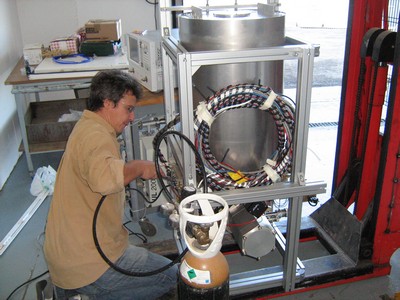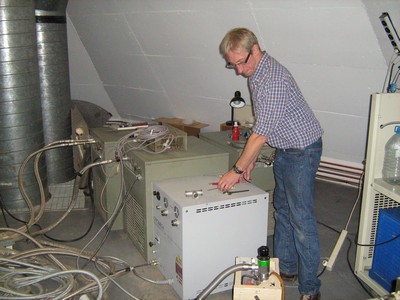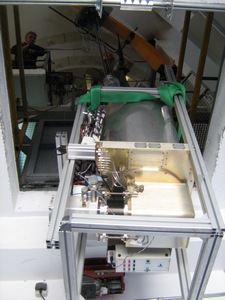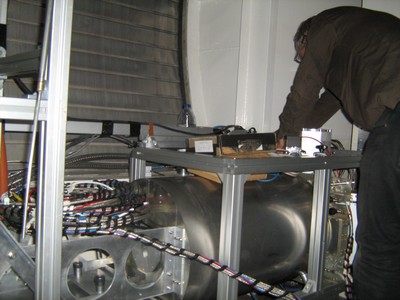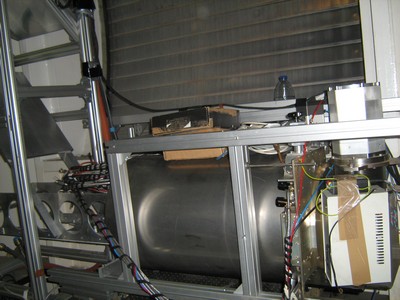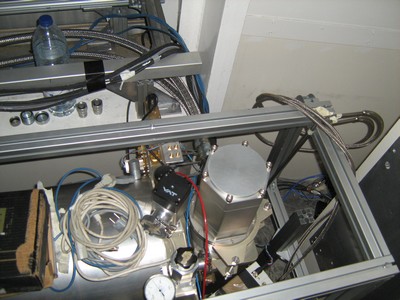|
Size: 4265
Comment:
|
Size: 7625
Comment:
|
| Deletions are marked like this. | Additions are marked like this. |
| Line 63: | Line 63: |
| === Arrays information === BAND 1.25mm (dichroic in transmission) - NICA_8c (132 pixels array, Hilbert dual-polarisation design, pixels pitch 2.3mm on both x and y <=> 1.23 Fλ with the current optics), 20nm (IRAM film), substrate 0.3mm, backshort 0.7mm. Amplifier Caltech SiGe (0.5-4GHz). From laboratory measurements we estimate an NET of about 2.5-4 mK/sqrt(Hz) per pixel. Resonances at 1.3-1.5GHz. BAND 2mm (dichroic in reflection) - NICA_8c (132 pixels array, Hilbert dual-polarisation design, pixels pitch 2.3mm on both x and y <=> 0.77 Fλ with the current optics), 20nm (IRAM film), substrate 0.4mm, backshort 1.1mm. Amplifier IRAM 1-2GHz. From laboratory measurements we estimate an NET of about 4-6 mK/sqrt(Hz) per pixel. Resonances at 1.3-1.5GHz. == Day to day log book of observations == [[D2DLogNika3|ObsLogBook]] |
|
| Line 73: | Line 82: |
==== Wednesday 12 October 2011 ==== Unloading has started at Pico Veleta. Beside a leak in the cryostat, a connector size problem with the compressor and the explosion of one of the foot of the anti-vibration table, the installation of NIKA and its auxiliary equipment went fine and smoothly. System pumped, cryocooler switched on, temperature decreasing gently ==> so far so good. ||{{attachment:NikaRun3/01_Alessandro_finds_a_leak_in_NIKA.jpg| 01_Alessandro_finds_a_leak_in_NIKA}} {{attachment:NikaRun3/02_Philippe_installs_the_compressor.jpg| 02_Philippe_installs_the_compressor}} {{attachment:NikaRun3/03_lifting_NIKA.jpg| 03_lifting_NIKA}} {{attachment:NikaRun3/04_Alain_plugs_the_He_lines.jpg| 04_Alain_plugs_the_He_lines}} {{attachment:NikaRun3/05_NIKA_installed.jpg| 05_NIKA_installed}} {{attachment:NikaRun3/06_NIKA_cold_head.jpg| 06_NIKA_cold_head}}|| ==== Tuesday 13 October 2011 ==== Between 15h15 and 16h25 we changed the feet of the anti-vibration table (lift NIKA, put aluminum legs on it, remove the table, change the feet, put everything back in place), installed the roach boards, and plug all the electronics. The cryostat is cooling down slowly... maybe a bit too slow, so we put a bit more pressure in the compressor. Now the cooling rate seems OK, but it is still too soon to know whether we will be cold enough to start the dilution; if we can't reach the base temperature of the crycooler tomorrow we will have to bring the compressor up in the cabin. Hope fully this will not be necessary. After discussions between the NIKA team, Santiago, and the 2 project PI of the afternoon and night (N. Biver and C.Thum) we have taken the decision to do the laser alignment tonight at 2h30; that's the slot which arrange the best everybody. We did the laser alignment as planed, it went fine and took exactly 1 hour from the moment Clemens stopped his scan to the moment we returned in the control room. Near 4h in the morning the cryocooler reached a base temperature of ~5K: colder as ever, even better than in lab! We start the condensation of the He3-He4 mix; the dilution will cool down the array stage in the morning. ==== Friday 14 October 2011 ==== This morning the detectors reached their base temperature around 80mK. The resonances of the KIDs are there for the 2 arrays, and the noise spectrum is pretty flat. Little problems to solve: temperature oscillations, resonances shifts, spikes that looks like cosmics. Nothing bad, things are doing well. |
NIKA run #3 (18 - 24. Oct 2011)
Test run plan:
# |
Dates |
Main Task |
Details |
Lead (Neel / IRAM) |
Support |
|
11.10. Tuesday |
|
Arrival of first visitors and truck in Granada |
|
|
|
12.10. Wednesday |
Mount and cool down |
Limited access to Rx-Cabin: ~ 11h - 17h |
Alain / Samuel |
Santiago |
|
13.10. Thursday |
Cool down / Network / System checks |
Limited access to Rx-Cabin: up to 2 hours in afternoon |
Alain / Samuel |
Miguel |
|
14.10. Friday |
Possible displacement of PTC compressor / cool, checks |
Limited access to Rx-Cabin: up to 2 hours anytime |
Alain / Samuel |
Dave ? Santiago ? |
|
15.10. Saturday |
Possible displacement of PTC compressor / laser alignment |
Limited access to Rx-Cabin: up to 2 hours anytime |
Alain / Samuel |
Dave ? Santiago ? |
|
16.10. Sunday |
cool down & checks or wait |
access to Rx-Cabin: 0 - 2 hours, probably not necessary |
Alain / Samuel |
|
|
17.10. Monday |
Observations (T21-11) |
start at 22h00 |
Alain / Samuel |
|
|
18.10. Tuesday |
Observations (T21-11) |
stop at 10h00, restart at 22h00 |
Alain / Samuel |
|
|
19.10. Wednesday |
Observations (T21-11) |
stop at 14h00, restart at 22h00 |
Alain / Samuel |
|
|
20.10. Thursday |
Observations (T21-11) |
stop at 14h00, restart at 22h00 |
Xavier, Alessandro / Samuel |
|
|
21.10. Friday |
Observations (T21-11) |
stop at 14h00, restart at 22h00 |
Xavier, Alessandro / Samuel |
|
|
22.10. Saturday |
Observations (T21-11) |
stop at 14h00, restart at 22h00 |
Xavier, Alessandro / Samuel |
|
|
23.10. Sunday |
Observations (T21-11) |
stop at 14h00, restart at 20h00 |
Xavier, Alessandro / Samuel |
|
|
24.10. Monday |
Observations (T21-11), Warm up |
stop at 14h00 |
Xavier, Alessandro / Samuel |
|
|
25.10. Tuesday |
Dismount and leave |
Access to Rx-Cabin: 10h30 - 14h00 |
Xavier, Alessandro / Samuel |
|
color table of the Run schedule
Staffing of the test run 3
- IRAM/Grenoble:
- 1 room: Samuel Leclercq (coordinator).
- Institut Néel:
- 3 rooms Oct 11 - Oct 18: Alain Benoit (PI) + (Christian Hoffmann), Alessandro Monfardini (co-PI) + Philippe Camus, Martino Calvo + (Angelo Cruciani).
- 4 rooms Oct 18 - Oct 25: Alain Benoit (PI), Alessandro Monfardini (co-PI), Martino Calvo + Angelo Cruciani, Christian Hoffmann + Nicolas Boudou.
- IPAG:
- 1 room Oct 17 - Oct 25: François-Xavier Désert.
- IRAM/Granada:
- 2 rooms: Operators: Juan / Salvador.
- 1 room: Astronomers of Duty: Sandra / Nicolas.
- 2 rooms: cooks and cleaning personal.
- 1 room: receiver engineer.
- 2 rooms: several from various groups.
- Visitors astronomers (heterodynes):
- 2 rooms.
The total number of rooms at the Pico is 14 => always full with above room atribution.
For more details on traveling and presences dates see the color table of the NIKA staff schedule.
List of astronomical target
Complementary information
Minutes of the September 9 2011 meeting for the preparation of the NIKA run 3
Test plan document as previous years probably not necessary since it would be redondant with all the above information (however if somebody thinks it would still be useful, please tell me and I'll write a test plan similar to previous years - Samuel).
Arrays information
BAND 1.25mm (dichroic in transmission) - NICA_8c (132 pixels array, Hilbert dual-polarisation design, pixels pitch 2.3mm on both x and y <=> 1.23 Fλ with the current optics), 20nm (IRAM film), substrate 0.3mm, backshort 0.7mm. Amplifier Caltech SiGe (0.5-4GHz). From laboratory measurements we estimate an NET of about 2.5-4 mK/sqrt(Hz) per pixel. Resonances at 1.3-1.5GHz.
BAND 2mm (dichroic in reflection) - NICA_8c (132 pixels array, Hilbert dual-polarisation design, pixels pitch 2.3mm on both x and y <=> 0.77 Fλ with the current optics), 20nm (IRAM film), substrate 0.4mm, backshort 1.1mm. Amplifier IRAM 1-2GHz. From laboratory measurements we estimate an NET of about 4-6 mK/sqrt(Hz) per pixel. Resonances at 1.3-1.5GHz.
Day to day log book of observations
Offline processing results
Daily reports
Monday 10 October 2011
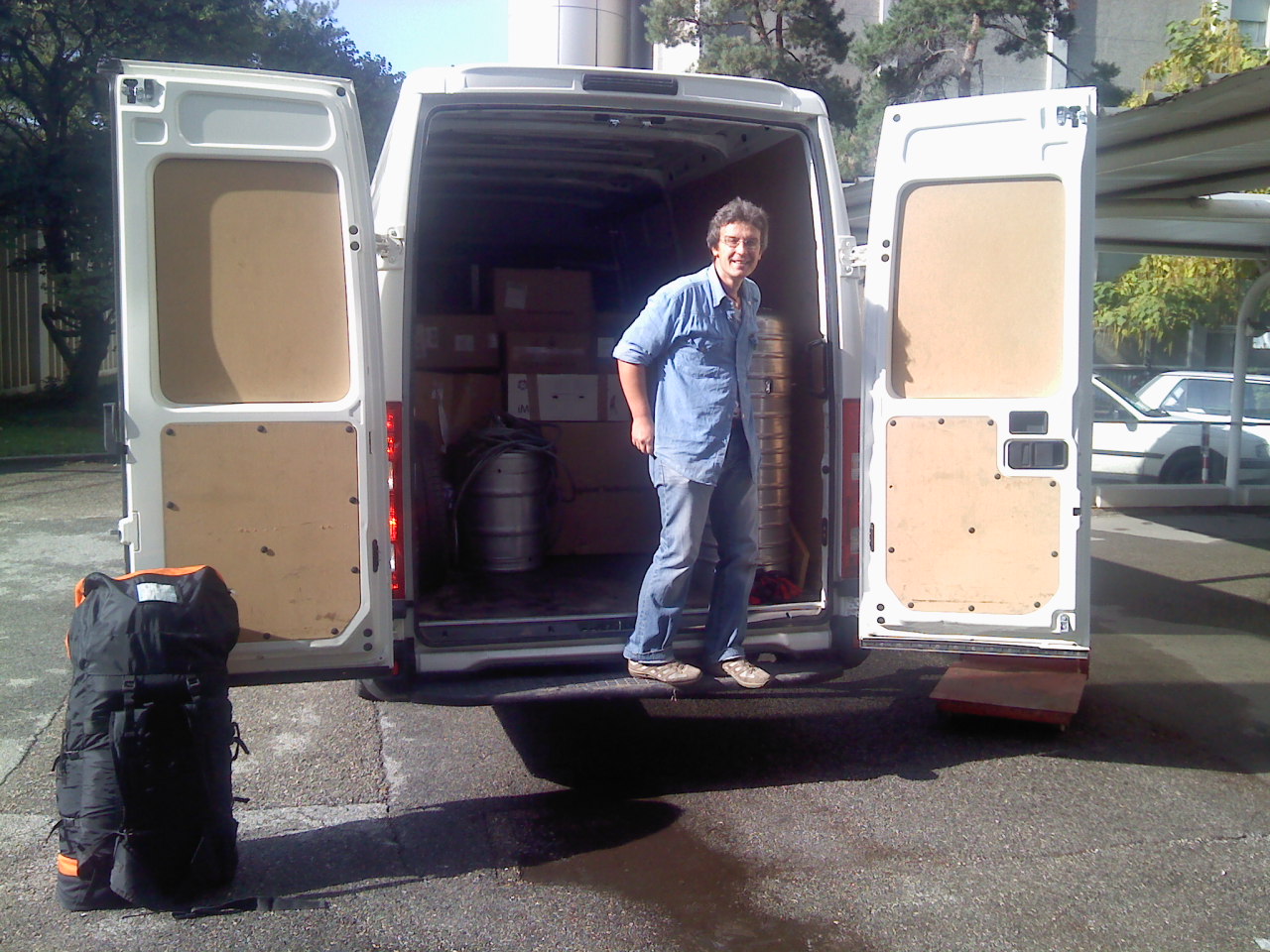
Tuesday 11 October 2011
The van left on Tuesday fully loaded and with 4 inflated tyres and one spare for Spain (Alessandro, Philippe and Martino are driving). Samuel and Alain to join them in Granada.
Wednesday 12 October 2011
Unloading has started at Pico Veleta.
Beside a leak in the cryostat, a connector size problem with the compressor and the explosion of one of the foot of the anti-vibration table, the installation of NIKA and its auxiliary equipment went fine and smoothly. System pumped, cryocooler switched on, temperature decreasing gently ==> so far so good.
|
Tuesday 13 October 2011
Between 15h15 and 16h25 we changed the feet of the anti-vibration table (lift NIKA, put aluminum legs on it, remove the table, change the feet, put everything back in place), installed the roach boards, and plug all the electronics. The cryostat is cooling down slowly... maybe a bit too slow, so we put a bit more pressure in the compressor. Now the cooling rate seems OK, but it is still too soon to know whether we will be cold enough to start the dilution; if we can't reach the base temperature of the crycooler tomorrow we will have to bring the compressor up in the cabin. Hope fully this will not be necessary.
After discussions between the NIKA team, Santiago, and the 2 project PI of the afternoon and night (N. Biver and C.Thum) we have taken the decision to do the laser alignment tonight at 2h30; that's the slot which arrange the best everybody.
We did the laser alignment as planed, it went fine and took exactly 1 hour from the moment Clemens stopped his scan to the moment we returned in the control room. Near 4h in the morning the cryocooler reached a base temperature of ~5K: colder as ever, even better than in lab! We start the condensation of the He3-He4 mix; the dilution will cool down the array stage in the morning.
Friday 14 October 2011
This morning the detectors reached their base temperature around 80mK. The resonances of the KIDs are there for the 2 arrays, and the noise spectrum is pretty flat. Little problems to solve: temperature oscillations, resonances shifts, spikes that looks like cosmics. Nothing bad, things are doing well.

